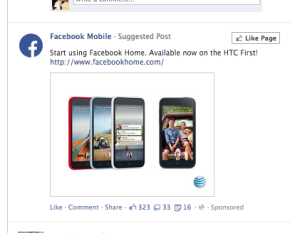Doing Direct Response On Facebook: Using Facebook Pixels
All advertisers on Facebook aim to turn users into customers. At the end of the day, marketing is about generating sales and making money, of course. But when you run ads on Facebook, it can be difficult to see to the end of the funnel. Often, advertisers get lost in the quantity of metrics and data […]
All advertisers on Facebook aim to turn users into customers. At the end of the day, marketing is about generating sales and making money, of course. But when you run ads on Facebook, it can be difficult to see to the end of the funnel. Often, advertisers get lost in the quantity of metrics and data available on Facebook and forget that their efforts shouldn’t stop there.
Recently, Facebook has been actively adding offerings to make the platform more viable for Direct Response (DR) campaigns. This effort is a clear result of the increased sophistication of clients running Facebook ads.
Standard Domain Ads
Direct Response campaigns have existed on Facebook for some time. Key to measuring the success of those campaigns is the ability to track users once they leave Facebook, via pixels. And, the only Facebook ad that accepted pixels was the Standard Domain Ad.
These ads are limited to the right-hand rail placement and the smaller ad size that accompanies that placement. For a long time, only click-based conversions could be tracked. Running said pixels usually required advertisers to work with second- and third-party tracking systems, making the process fairly complicated.
Facebook Pixels
Enter Facebook Pixels, the platform’s own system of tracking ad conversion data. Like any other type of tracking system, Facebook pixels allow you to collect data throughout the conversion funnel. This means that you can see when people are clicking, how far they’re getting in the flow, and where they’re dropping off. By understanding the complete funnel, you can make better advertising decisions by targeting people similar to those that are converting. And, the advantages of using Facebook’s tool over another system are significant.
Creating A Facebook Pixel
FB pixels are simple to create and implement. Creation is extremely easy and can be done entirely in Power Editor. On the left navigation bar, click “Conversion Tracking” and then “Create Conversion Pixel.” Name the pixel and select one of the categories. Once you’ve created it, you’ll be able to “View Pixel Code.” This is the snippet of code that you will place on the landing page where you want to track conversions.
Post-Click And Post-Impression
Facebook Pixels allow for both click and view tracking with a single pixel, rather than multiple. For advertisers who are used to having to aggregate click and view data from different sources, this is a welcome change. They can also be used to pass back basket size; in other words, they allow you to see exactly how much each converter is spending on your site, rather than just that he or she spent something.
Ad Level Attribution
Facebook pixels allow for ad-level attribution. Advertisers can see exactly which ads have driven conversions, rather than just higher-level categories or targeting groups like age and gender. This makes optimization much more refined, because you can isolate ALL top-performing elements and optimize toward them. For DR campaigns, understanding those specific drivers of performance is essential for high conversion rates and ROI.
Page Posts And Newsfeed

This is a game-changer. Newsfeed, on both desktop and mobile, is the most sought-after real estate on Facebook. Ads are substantially are larger and more eye-catching, cost-per-click is lower, and click-through and engagement rates are massively higher.
Before FB pixels, advertisers could not use these ads types for DR campaigns because there was no way to track downstream conversions. Now that Facebook pixels are available, more and more advertisers are moving their DR strategy to incorporate Page Post ads to take advantage of the Newsfeed’s prime real estate and the increased appeal of these larger ads.
Streamlined Optimization
Optimization is a bit easier with Facebook pixels, too. We talked about how the ad-level data allows you to optimize in a more sophisticated and precise way. Facebook also offers special bidding strategies that work well with DR campaigns.
If you’ve already created your pixel(s), you can specify which ones you want to focus on and then use a Facebook optimized CPM bid to do the hard work for you. It looks at the audience, understands who is responding most to your pixel, and uses its advanced algorithm to serve ads automatically to users who are more likely to convert.
Putting It All Together
Hopefully, you’re now convinced of the efficacy of using Facebook Pixels to run conversion-based campaigns. For many advertisers, the introduction of this system has helped tie their whole social media marketing strategy together.
It’s only in running these types of DR campaigns that we can really understand the value of the communities that we’ve built up on Facebook. It certainly helps legitimize dollars spent on acquiring fans when you can run an acquisition campaign and see that fans have converted downstream at a 5x higher rate than non-fans. Without Facebook pixels, such metrics would be much harder to quantify.
Opinions expressed in this article are those of the guest author and not necessarily MarTech. Staff authors are listed here.
Related stories
